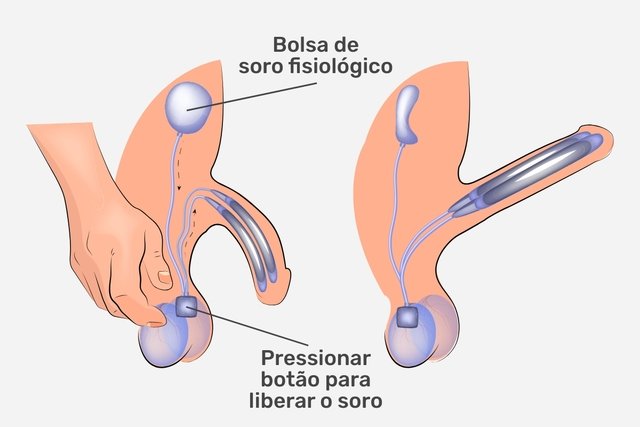A penile prosthesis is an implant that is placed inside the penis to produce an erection, and can therefore be used to treat sexual impotence in men, in cases of erectile dysfunction of various causes, refractory or non-adaptive to clinical treatment.
Penile prosthesis is generally an end-of-line treatment, that is, it is only recommended for men who cannot obtain satisfactory results with the use of medication or other treatments, as the surgery is irreversible.
It is important that the man talks to the urologist to assess the need for the prosthesis and, if recommended, the best type of prosthesis.

When is it indicated
A penile prosthesis may be recommended by a urologist in some situations, the main ones being:
- Erectile dysfunction that had no solution after using medication;
- Peyronie’s disease;
- Paraplegia or quadriplegia;
- Reconstruction of the genital organ.
The recommendation for the prosthesis is made by the doctor after carrying out urological examinations, characteristics of the penis and the man’s general health.
Types of penile prosthesis
The type of penile prosthesis must be indicated by the doctor according to the objective of the treatment and the person’s age, the main ones being:
- Semi-rigid or malleable: made with material that keeps the penis always erect, and can be placed in 3 positions that allow intimate contact and comfort for the man during his daily life, this type being more suitable for older people or those who have problems with their hands that prevent them from operating the device responsible for inflating the prosthesis;
- Inflatable: It is made with 2 flexible cylinders inside the penis, which can be filled with saline solution to facilitate an erection, allowing it to be deflated after intimate contact. For the erection to happen, the man must activate a device so that the prosthesis is inflated.
In addition, there is the articulating prosthesis, however this type of penile prosthesis is no longer being used due to the structure of the prosthesis, which can interfere with rigidity.
How is the surgery done
Penile prosthesis surgery is performed by a surgeon and lasts around 45 minutes, being carried out under general anesthesia and therefore the hospital stay is approximately 1 to 2 days.
Recovery from surgery is relatively slow, lasting up to 6 weeks, after which the man will be able to initiate intimate contact, according to the doctor’s instructions. During this period, some important precautions include:
- Keep the penis facing upwards to prevent it from healing folded downwards;
- Avoid intense physical activities or impact sports during the first 2 months;
- Perform proper hygiene of the intimate region.
However, all precautions must be provided by the doctor, as they may vary according to the type of prosthesis or surgery.
What is sexual intercourse like with the prosthesis?
The experience of having sex with a penile prosthesis varies from man to man, however, it is important to note that the rigidity of the head of the penis will not change during erection, remaining soft.
As for sensitivity, nothing is changed and the man continues to be able to ejaculate, without compromising his ability to have children.
Possible risks of placing the implant
Although it is an increasingly used surgery, placing an implant can still have some risks, such as:
- Infection;
- Rejection of the prosthesis;
- Adhesion of the prosthesis to the tissues inside the penis;
- Extrusion or exposure of the prosthesis(s).
As there are risks, men should be aware of symptoms that may indicate complications, such as swelling of the penis, intense pain, redness or even pus coming out of the penis, for example.
If any of these symptoms appear, it is important to return to the urologist or go to the hospital to identify the complication and begin appropriate treatment.

Sign up for our newsletter and stay up to date with exclusive news
that can transform your routine!
Warning: Undefined array key "title" in /home/storelat/public_html/wp-content/plugins/link-whisper-premium/templates/frontend/related-posts.php on line 12
Warning: Undefined array key "title_tag" in /home/storelat/public_html/wp-content/plugins/link-whisper-premium/templates/frontend/related-posts.php on line 13




